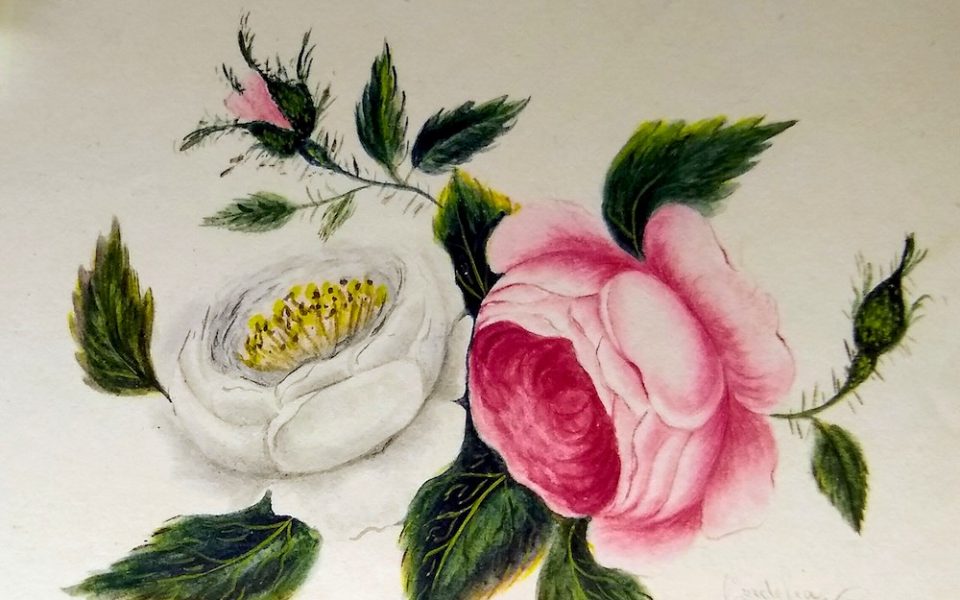“With the Moravian community it was basically two things over and over again: roses and forget-me-nots,” archivist J. Eric Elliott says. “In German, forget-me-not is actually forget-mine-not. The German story is of two forlorn lovers walking along the River Rhine, and for some reason the guy falls off the cliff and as he falls he says, ‘Forget mine not!,’ which means, ‘Forget my love not.’”
The Moravian Archives in Winston-Salem holds 265 years of community history in the forms of family collections, correspondences, diaries, travel books and newspapers, as well as the ongoing stories of flowers in Moravian society. The Languages of Flowers in Moravian Wachovia exhibit, examining the heritage of the Moravians’ employment of flowers in five distinct ways, and the legacy of those floral languages, will be on display in the lobby of the Archie K. Davis Center through April 30 before traveling to the Bethania Visitor Center and the Forsyth County Central Library. Languages is the first of three related exhibits; the second, anticipated this summer, will shine light on four distinguished Moravian botanists and the third will focus on the local evolution of gardens over the last 150 years.
Lewis David de Schweinitz, a renowned natural historian and mycologist who served as the administrator for the Moravian Church in Salem from 1812-21, was among these scientist-preachers. During his lifetime, he identified thousands of species of fungi in the region and would co-found the Academy of Natural Sciences in Philadelphia.
Carl Linnaeus had introduced binomial nomenclature, the formal two-term scientific naming system in Species Plantarum, in 1753, the same year the Moravians settled in colonial North Carolina. Like their peers in Europe, the educated populace took to designating new species on long, leisurely walks, as evidenced in handwritten artifacts in the exhibit, which first analyzes Moravians’ relationship to flowers through the lens of natural history and botany studies.
Flowers’ utility, too, mattered to the Moravians — the first known record of a planned garden with a plant list from 18th Century America is from this community — but communication and celebration traditions illuminate nuances of cultural norms.

Outside of symbolic language in autograph books and artwork, changes in Moravian birthday customs, in particular, offer unique insight. A 40-year survey of Maria Schaaf’s birthday cards evinces the comparatively formal designs favored by friends still living in Europe, in which ornate flowers encircle birthday wishes. While the earliest cards feature explicitly religious themes and scripture, an increasingly collegial tone emerges and focus shifts to the floral embellishments that adorn devotional verse numbers.
On display nearby, a page in an unmarked book features a hand painting of a pink rose “embracing” a white one with its vine. This appealing artwork yields deeper meaning when placed in context of the Single Sisters House in the Salem community, built to provide single women and girls (who wore pink ribbons) and widows (who wore white) with housing and space for community service.
“What more symbolic gesture of sisterhood than the younger woman, as a flower, putting her arm around the widow,” Elliott says.
But the Moravians valued aesthetic beauty for simple pleasure’s sake, too, as revealed in old photographs and diaries. An early 19th Century diary of Susanna Elisabeth Kramsch is one artifact that illustrates each of these languages.
“She would walk around the neighborhood picking up samples of flowers and she would write about them just as her husband did: scientifically,” Elliott says. “It was scientific knowledge mixed with a diary of all the terrible things happening in her life, particularly her husband Samuel’s ongoing illness. So why would she pick up a flower? Well, you can make a tea with yarrow flower to help soothe someone’s stomach; it symbolizes lasting love and hope; it also could be that it was a happy memory, that [she and Samuel] used to collect them together because it was such an everywhere plant. It’s the kind of thing that puts some humanity into [a text] that would otherwise be flat.”
Learn more online here and visit at 457 S. Church St. (W-S).
Join the First Amendment Society, a membership that goes directly to funding TCB‘s newsroom.
We believe that reporting can save the world.
The TCB First Amendment Society recognizes the vital role of a free, unfettered press with a bundling of local experiences designed to build community, and unique engagements with our newsroom that will help you understand, and shape, local journalism’s critical role in uplifting the people in our cities.
All revenue goes directly into the newsroom as reporters’ salaries and freelance commissions.


Leave a Reply